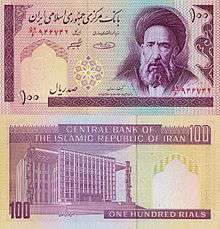Hassan Modarres
| Hassan Modarres | |
|---|---|
 | |
| Member of the Parliament | |
|
In office 11 July 1926 – 13 August 1928 | |
| Monarch | Reza Shah |
| Constituency | Tehran |
|
In office 11 February 1924 – 11 February 1926 | |
| Monarch |
Reza Shah Ahmad Shah Qajar |
| Constituency | Tehran |
| Majority | Ranked 1st |
|
In office 22 June 1921 – 11 June 1923 | |
| Monarch | Ahmad Shah Qajar |
| Constituency | Tehran |
|
In office 6 December 1914 – 13 November 1915 | |
| Monarch | Ahmad Shah Qajar |
| Constituency | Tehran |
| Personal details | |
| Born |
Seyyed Hassan Tabatabaei Ardestani c. 1870 Sarabeh, Ardestan, Persia |
| Died |
December 1, 1937 (aged 67) Kashmar, Khurasan, Persia |
| Nationality | Iranian |
| Political party |
|
| Alma mater | Najaf Seminary |
| Occupation | Teacher |
Seyyed Hassan Modarres (Persian: سید حسن مدرس c. 1870, Sarabeh, December 1 1937, Kashmar), was an Iranian Twelver Shi'a cleric and a notable supporter of the Iranian Constitutional Revolution. He was among the founding members, along with Abdolhossein Teymourtash, of the reformist party Hezb-e Eslaah-talab of the time, which was formed during the fourth national Majlis of Iran. He has been called "brave and incorruptible" and "perhaps the most fervent mullah supporter of true constitutional government."[1]
On 100 rials banknote
Biography
The sources disagree on his birthplace. Some mention that he was born in Shahreza in around 1870, while others mention that he was born in a village named Sarābe-Kachou (سرابهکچو) near Ardestan in the early 1870s, and that he moved to Shahreza when he was six. The second story is depandable.Having studied Islamic sciences in Isfahan and Najaf, Modarres turned to become a religious teacher in an Esfahan's madrasa. The name Modarres, that means "teacher", is because of his job there. In 1910, he was chosen by Najaf's cleric community and sent to Tehran to supervise the laws passed by the Majlis of Iran, to make sure they are not against the rules of sharia. Later, in 1914, he was elected as a Majlis representative of Tehran.
In 1916, during the World War I, he migrated to Iraq, Syria, and Turkey together with a handful of other politicians, and served as the Minister of Justice in a cabinet formed in exile by Nezam os-Saltaneh. After returning to Iran, he was elected in the Majlis elections a few more times. Modarres fought against the presence of British forces in Persia, vigorously opposing the proposed 1919 agreement that would have transformed Iran into a British protectorate.
In the early 1920s he also played a role in preventing Reza Khan (the prime minister at the time) from abolishing the monarchy (the Qajar Dynasty) and declaring a republic, and less successfully opposed Reza Khan's deposing of the Qajar dynasty in 1925. Sayyed Modaress was openly critical of Reza Shah's rule and was placed under imprisonment in retaliation for his criticisms. A few years after a November 1926 assassination attempt against him, Modarres was expelled to Khaf and later to Kashmar. He was finally killed in a prison in December 1937. His death is regarded as martyrdom and the martyrdom day (10th of Azar) is known in Iran as Majlis day (day of the parliament).
Ruhollah Khomeini, who later became the Supreme Leader of Iran after the Iranian Revolution, was among Modarres's students.
Modarres is depicted on the obverse of the Iranian 100 rials banknote.[2]
Notes
- ↑ Mottahedeh, Roy, The Mantle of the Prophet : Religion and Politics in Iran, One World, Oxford, 1985, 2000, p.224
- ↑ "Banknotes & Coins - 100 Rials". cbi.or. Retrieved 24 March 2009.
Sources
- The Persian Encyclopedia's entry on Modarres.
- Mohammad Taghi Bahar, Taarikh-e Mokhtasar-e Ahzaab-e Siaasi-e Iraan (A Short History of Political Parties of Iran), Amirkabir, 1978.
- Yadegari, Amir Hossein (November 2005). "Siāsatmadār-e Dindār", Hamshahri-e Māh, ("Religious Politician", Our Fellow Citizen) Ābān 1384 A.P., page 4.
- Abrahamian, Ervand, Iran Between Two Revolutions, Princeton University Press, 1982
- Mottahedeh, Roy, The Mantle of the Prophet : Religion and Politics in Iran, One World, Oxford, 1985, 2000
External links
| Wikimedia Commons has media related to Hassan Modarres. |
- Seyyed Hassan Modaress at www.qajarpages.org
- Modaress on irib.ir
- Modarres on irib.ir
- Modarres Dar Ā'in-e Che'hel Sāl Mobārezeh (Modarres in the Reflection of Forty Years Struggle), Khāne-ye Mellat (Nation's Home)
